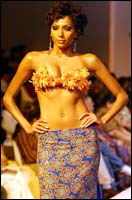Not too long ago, Indian designers sat in their studios and drew creations for a select band of rich socialites and Non Resident Indians. The clothes were termed haute couture and the creations priced nothing less than a few thousands.
Today, the same band of designers are busy calculating the giant middle class market with increasing disposable income and aspirations to designer wear in India and how they can get a slice of it.
From veterans like Rina Dhaka, Suneet Varma and Ritu Kumar to newbies like Narendra Kumar and Varun Bahl, designers are succumbing to the lure of prêt -- off the rack ready to wear labels that fit the 'affordable' price range of Rs 300-3000 as opposed to haute couture where designers do single pieces customised to individual tastes and which costs many thousands.
"There is a lot of economics associated with the fashion business. It is about selling, it is about generating funds to expand and only pret can help do that," says designer Narendra Kumar who has a pret line called 'Chai'. Kumar already has four dedicated stores across the country selling his 'Chai' label.

Within the next year he wants to open five new stores. He says pret will give him ten times the turnover that he can hope to get with haute couture.
"Worldwide for any fashion house, the bread and butter comes from pret. Haute couture is what designers do indulge themselves," says Kumar whose collection at the Lakme India Fashion Week this year was appreciated for its wearability.
Kumar used natural fabrics like chinos, denim and cotton knits apart from leather and georgettes to create a range priced between Rs 300 to Rs 1,200. The evening dresses were priced around Rs 3500.
Increasing disposable income among the Indian middle class, greater exposure to fashion trends and the desire to look good through the day is driving the demand for pret.
"Women now want to look good through the day. Earlier, it was that women wanted to dress up just for the evenings so designers made evening wear only. Now women want to look good through the day and that calls for pret," says designer Wendell Rodricks.
Pret is clearly the way to go as evinced by the partnerships that designers are trying to work out with retail stores.
Designer Raghavendra Rathore has partnered with retail chain Shopper's Stop to launch a new co-branded range of merchandise. The production and retailing will be handled by Shoppers' Stop, while the designing and quality control will Rathore's responsibility.
The move will put a Raghavendra Rathore within the reach of every woman who walks into one of the Shoppers' Stop stores in India.
"It is a great step for the industry. This is the kind of thinking that designers have been looking for. It will lead to a setup where designers only have to do the designing and production; marketing and other aspects will be taken care of by others," says Rathore.

The yet-to-be-named line, which will retail exclusively at all Shoppers' Stop outlets across the country, is being priced between Rs 500 and Rs 1,500
Other designers are dreaming of similar tie-ups.
Payal Jain, whose designs are again known for their popular appeal, recently launched her prêt line called 'ADO'.
"The sheer population in this country makes its imperative for designers to look beyond haute couture. It also makes the Indian market very important. The kind of numbers that you can do in India you cannot hope to even in terms of exports. Pret will work in India if we can get stores like Shopper's stop and Lifestyle to stock labels," says Jain.
Last year at the Lakme India Fashion Week, Jain showed diffusion. This year, she went prêt. In the last one year Jain has been putting together the back end needed to sell prêt.
"I felt that the market is ready for prêt. But to do prêt you have to have your production line set up," she says.
Jain has got herself a business partner and has found a huge factory near Delhi capable of churning out over 1000 pieces a month that will work exclusively for her.
Getting the logistics right is one of the biggest challenge of going pret.
"Pret requires the retailing infrastructure to improve. It is not just about getting the fashion forecast right but also about knowing what sells in the stores and how much pieces you need every month," says Narendra Kumar.
The move towards prêt has meant that the designers too are now wary of over the top or outrageous designs and want to do clothes, which will appeal to the widest section of the audience.
Le Spice, the prêt label by Suneet Varma is an example.
In wonderful bubblegum and candy colors of blue, white, pink and yellow, Varma's show at the Lakme India Fashion Week was breezy, summery chic. Think Yash Chopra films or Kuch Kuch Hota Hai.
It is a collection that will sell everywhere from Ludhiana to Louisiana, says Varma proudly.
But getting that kind of appeal hasn't been easy. Varma has been working on his pret line for the last 10 months trying to get the pricing and the look right.
Pricing is the most important aspect of going pret. Pret survives on volumes and in India's price sensitive market getting the right price point is essential if designer needs to go pret successfully.
And to ensure that they get their pricing right, designers have to keep a check on their creative urges.
The most expensive outfit in Suneet Varma's Le Spice collection this year was a pair of white embroidered pants that costs Rs 2000. The collection begins at Rs 800.
Varma says he had to exercise discipline to ensure he didn't go overboard with the embroidery on the pants, which would in turn push up its price.

"Even if I wanted to do more beadwork on it, I would tell myself no. I had to keep telling myself that this a pret collection and that pricing is the most important part of it," says Varma.
He did make a few blunders on the way. There were clothes that he says he had to sell below the cost price because it was too expensive for pret, others where he incurred losses because he didn't get his costing right and a few where the backend logistics were not perfect so there were just not enough pieces in the market despite the fact that the garment was among the bestsellers in the range.
The czars of Indian fashion are, however, turning their nose up at pret. Designer Tarun Tahiliani, who ranks among the biggest labels in the country, says he will do pret only if he can be in 50 stores from day one.
"Pret requires economies of scale. It is not easy to do it. Personally too, I am a stage where I do not get excited about doing 1500 peacock motif t-shirts to be sold in stores," he says.
While Tahiliani is open to the idea of a pret line sometime in the future, designer Rohit Bal completely dismisses it.
"I can't do cheap clothes for women. I think women should be dressed richly in expensive and beautiful clothes. They deserve that. Probably I can do inexpensive clothes for men but I can't do it for women at all," he says.
Tahiliani's and Bal are staying away from pret, but others are busy making plans for their pret collection.
Designer Suneet Varma wants to turn Le Spice into the Mango or Zara of India--stylish, chic yet affordable.
And the response he has gotten till now, he says, is more than encouraging.
"I think this is the most successful business venture in my 17 years as a designers. Couture will always be there but I now want to take my pret line to new heights," says Varma.
Photographs: Jewella C Miranda






 © 2025
© 2025